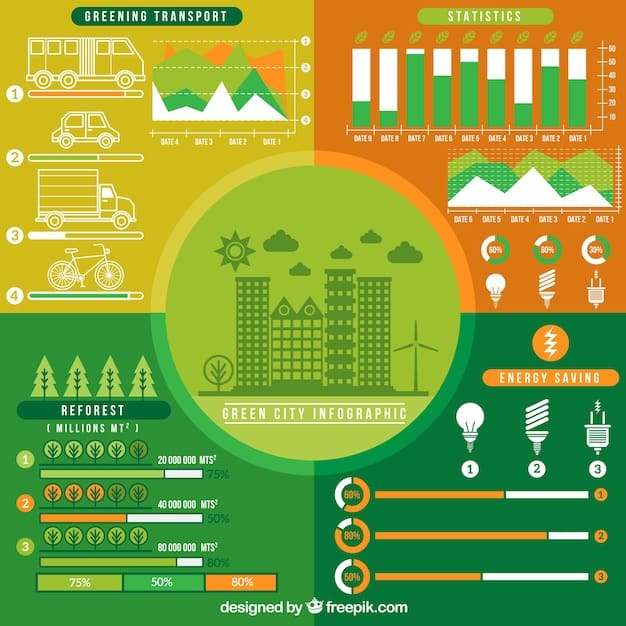Electric Vehicle Study: 60% Carbon Emission Reduction vs. Gas Cars

A recent Electric Vehicle Environmental Impact Study reveals that electric vehicles (EVs) reduce carbon emissions by 60% compared to gas-powered cars, highlighting a significant step towards a sustainable transportation future and underscoring the need for broader EV adoption.
A new Electric Vehicle Environmental Impact Study: New Report Shows Electric Vehicles Reduce Carbon Emissions by 60% Compared to Gas-Powered Cars. The report highlights the substantial environmental benefits of switching to electric vehicles.
Electric Vehicles: A Cleaner Transportation Alternative
The transportation sector remains a significant contributor to global carbon emissions. However, electric vehicles (EVs) are emerging as a viable and increasingly popular solution to mitigate this environmental impact. Recent studies underscore the potential of EVs to significantly reduce carbon footprints.
Compared to traditional gasoline-powered cars, EVs offer a pathway to a more sustainable future. But what exactly does the new report say about the specific reduction in carbon emissions? Let’s dive into the details of this important research and its implications for the environment and the automotive industry.
Key Findings of the Electric Vehicle Environmental Impact Study

The Electric Vehicle Environmental Impact Study delivers some compelling findings that highlight the environmental advantages of electric vehicles. The core finding, of course, is the substantial reduction in carbon emissions. Delving deeper, the study explores the nuances of this reduction across different regions and usage scenarios.
Specifically, the report analyzes the full lifecycle emissions of EVs, from manufacturing to operation and disposal. It provides a comprehensive view of the environmental impact, acknowledging both the benefits and the remaining challenges. Here are some key aspects that the study covers:
Lifecycle Emissions Analysis
The study meticulously analyzes the lifecycle emissions of both electric and gasoline-powered vehicles. This involves assessing the carbon footprint associated with each stage, including manufacturing, fuel production (or electricity generation), vehicle operation, and end-of-life disposal.
Regional Variations in Grid Emissions
The environmental performance of EVs varies depending on the energy sources used to power the electricity grid. Regions with a higher proportion of renewable energy sources, such as solar and wind, exhibit even greater reductions in carbon emissions when EVs are used.
- Manufacturing impact: The study evaluates the carbon footprint of manufacturing EV batteries and other components.
- Operational emissions: It calculates the emissions resulting from electricity generation to power EVs.
- Comparative assessment: The report compares these emissions to those of gasoline-powered cars, providing a clear benchmark.
- Policy Implications: The research aims to provide valuable insights for policymakers to promote EV adoption and sustainable transportation.
In summary, the Electric Vehicle Environmental Impact Study emphasizes the significant potential of EVs to mitigate carbon emissions. However, it also acknowledges the importance of regional factors and the need for continued efforts to improve sustainability throughout the EV lifecycle.
How EVs Achieve a 60% Reduction in Carbon Emissions
The claim that electric vehicles reduce carbon emissions by 60% compared to gasoline cars raises an important question: how is this reduction achieved? This percentage reflects the fact that EVs directly emit zero tailpipe emissions. The savings comes from the reduction in consumption fossil fules.
Beyond zero tailpipe emissions, the entire lifecycle of an EV contributes differently to overall emissions. The advantage stems from several key factors, including energy efficiency, renewable energy integration, and advancements in battery technology. Let’s explore these elements in more detail:
Energy Efficiency and Regenerative Braking
Electric vehicles are inherently more energy-efficient than gasoline-powered cars. They convert a higher percentage of energy into motion, reducing energy waste. Regenerative braking systems further enhance efficiency by capturing energy during deceleration and feeding it back into the battery.
Renewable Energy Integration
The environmental performance of EVs is closely tied to the energy sources used to generate electricity. When EVs are powered by renewable energy sources like solar, wind, or hydropower, their carbon footprint shrinks dramatically. Integrating more renewable energy into the grid is crucial for maximizing the environmental benefits of EVs.
To achieve a 60% reduction in carbon emissions, several key factors come into play:
- Zero Tailpipe Emissions: EVs have no tailpipe emissions, directly reducing air pollution.
- Energy Efficiency: EVs convert a higher percentage of energy into motion compared to gasoline cars.
- Regenerative Braking: Capturing energy during deceleration and feeding it back into the battery helps improve efficiency.
- Renewable Energy: When powered by renewable sources, EVs’ carbon footprint is significantly reduced.
In conclusion, the 60% reduction in carbon emissions is achieved through a combination of energy efficiency, renewable energy integration, and technological advancements. As technology progresses and renewable energy becomes more prevalent, the environmental benefits of EVs will continue to grow.
The Role of Battery Technology in Reducing Emissions

Battery technology is at the heart of electric vehicles, playing a crucial role in their performance, range, and environmental impact. Improvements in battery technology have contributed significantly to reducing emissions associated with EV production and operation.
The environmental impact of battery production is a critical consideration. As technology advances, manufacturers are exploring new materials and processes. Simultaneously, recycling initiatives are gaining momentum, aiming to recover valuable materials from end-of-life batteries and reduce waste. Here’s how battery technology plays a role in emission reduction:
Advancements in Energy Density
Increased energy density allows EVs to travel farther on a single charge. With reduced charging frequency, EVs can better utilize off-peak electricity and minimize strain on the grid during peak hours. This contributes to a more efficient and sustainable charging infrastructure.
Sustainable Material Sourcing
Sourcing battery materials sustainably is essential for minimizing the environmental impact of EV production. Manufacturers are exploring alternative materials, improving mining practices, and implementing traceability systems to ensure ethical and responsible sourcing throughout the supply chain.
These components form the basis:
- Energy Density: EVs can travel farther thanks to higher energy density in batteries.
- Sustainable Materials: Ethical material sourcing minimizes environmental impact.
- Recycling Initiatives: Recycling initiatives recover valuable materials from end-of-life batteries.
- Responsible Sourcing: Manufacturers explore alternative materials and implement traceability systems.
Significant advancements in battery technology are driving down production costs and enhancing energy efficiency. By developing more energy-dense, sustainable, and recyclable batteries, manufacturers are paving the way for a greener and more sustainable future for the automotive industry.
Policy Implications and Incentives for EV Adoption
Government policies and incentives play a crucial role in accelerating the adoption of electric vehicles and maximizing their environmental benefits. Policy support can encourage consumers to switch to EVs and encourage businesses to invest in charging infrastructure. Some examples are listed below.
Financial incentives, such as tax credits, rebates, and subsidies, can significantly reduce the upfront cost of purchasing an EV, making them more accessible to a broader range of consumers. Furthermore, these actions must be integrated:
Tax Credits and Rebates
Tax credits and rebates are effective financial incentives that encourage consumers to purchase EVs. These incentives help offset the higher upfront cost of EVs compared to gasoline cars, making them a more attractive option.
Investment in Charging Infrastructure
Investing in charging infrastructure is essential for supporting the growing number of EVs on the road. Accessible and reliable charging stations reduce range anxiety and provide convenience for EV drivers.
Policy support extends to:
- Financial Incentives: Attractive financial incentives reduce the upfront cost of EVs.
- Charging Infrastructure: Accessible charging stations reduce range anxiety.
- Emission Standards: Vehicle emission standards encourage EV adoption.
- Awareness Campaigns: Campaigns educate the public on the benefits of EVs.
Effective policies can help accelerate the transition to a cleaner and more sustainable transportation system.
Challenges and Future Directions for Electric Vehicles
Despite the clear environmental benefits of electric vehicles, several challenges remain that need to be addressed to ensure their widespread adoption and continued improvement. These challenges include the higher upfront cost of EVs, the limited availability of charging infrastructure, and concerns about battery range and charging times.
One of the most common concerns surrounding EVs is the limited availability of charging infrastructure, particularly in rural or underserved areas. Governments and private companies are working to expand the charging network, but more investment is needed to ensure that EV drivers can charge their vehicles quickly and conveniently. Other challenges that the future holds include:
Reducing Upfront Costs
One of the main barriers to EV adoption is the higher upfront cost compared to gasoline cars. As production scales up and battery technology improves, EVs are becoming more affordable, but continued efforts are needed to reduce costs further.
Expanding Charging Infrastructure
Limited charging infrastructure remains a challenge for EV drivers, especially in rural and underserved areas. Expanding the charging network, with both public and private investments, is crucial for supporting EV adoption.
Future advances in EV technology include:
- Cost Reduction: Lowering upfront costs makes EVs more accessible.
- Infrastructure Expansion: A robust charging network eases range anxiety.
- Battery Improvements: Increased range and faster charging enhance usability.
- Sustainability: Sustainable material sourcing and recycling minimize environmental impact.
Future advances will help overcome these hurdles, continuing to boost the adoption of EVs.
| Key Point | Brief Description |
|---|---|
| 🚗 60% Emission Reduction | EVs reduce carbon emissions significantly compared to gas cars due to zero tailpipe emissions. |
| 🔋 Battery Tech | Advancements in battery technology enhance energy density and promote sustainable material sourcing. |
| ⚡ Policy Support | Incentives like tax credits and investments in charging infrastructure encourage EV adoption. |
| 🌍 Sustainable Future | EVs pave the way for a greener future by reducing carbon emissions and promoting sustainability. |
Frequently Asked Questions (FAQ)
▼
The study’s main finding is that electric vehicles (EVs) reduce carbon emissions by 60% compared to gasoline-powered cars. This is a significant benefit for the environment.
▼
EVs achieve this reduction through zero tailpipe emissions, higher energy efficiency, regenerative braking, and integration with renewable energy sources, all of which lessen dependency to fossil fuels.
▼
Battery technology is crucial. Increased energy density allows EVs to travel farther, while sustainable material sourcing and recycling initiatives minimize environmental impact of production.
▼
Incentives include tax credits, rebates, and subsidies that reduce the upfront cost of EVs, making them more accessible. Investment in charging infrastructure is also crucial.
▼
Challenges include the higher upfront cost of EVs, limited charging infrastructure, and concerns about battery range and charging times. These are all things companies are working to surpass.
Conclusion
The Electric Vehicle Environmental Impact Study underscores the immense potential of electric vehicles to combat climate change. With a 60% reduction in carbon emissions compared to gas-powered cars, EVs represent a significant step towards a more sustainable transportation future. As technology advances and policies evolve, the path to widespread EV adoption becomes increasingly clear, promising a cleaner and healthier planet for generations to come.





